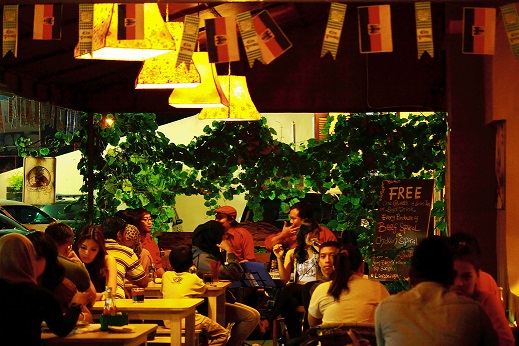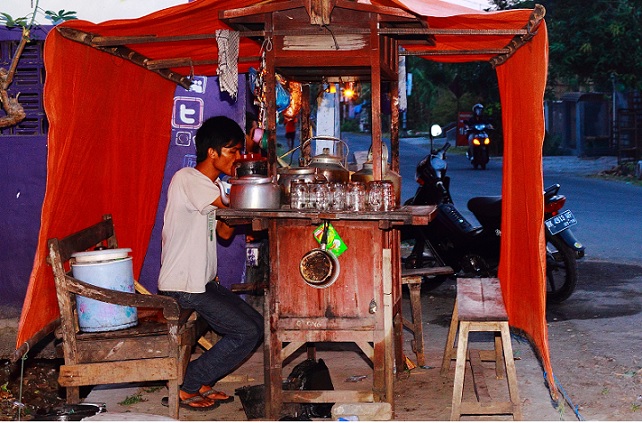The changing socio-economic status of Yogyakarta’s students threatens the survival of one of the city’s icons
An Ismanto
Angkringan are losing their appeal W. Nasela Danu Santoso
Students in Yogyakarta, Indonesia’s ‘education city’, used to be regular customers at angkringan, the plastic tent-covered food carts selling food and drinks at very affordable prices that were once a familiar part of the city’s night time street life. In recent decades, angkringan functioned as community hubs, bringing Yogyakarta’s lower status inhabitants into contact and communication with the budget-conscious youth enrolled in the city’s many educational institutions. Amid the smell of kretek cigarettes and murmured chatter, students and workers could interact over a drink and a few tasty snacks at a cost equivalent to a dollar a time.
Now, however, all that has changed. Abandoned by a new generation of wealthier students in favour of the trendy cafés springing up all over the city, angkringan have been forced to the margins, their customers confined to those with meagre incomes and traditional tastes.
An affordable alternative
Like other folk-based economic enterprises in Indonesia, the origins of angkringan are unclear. Iman Budi Santosa, a poet who has lived in Yogyakarta since the 1960s, does not recall seeing angkringan during his early years in the city. He says that when he and his fellow poets used to roam the iconic Jalan Malioboro during the 1970s, they usually gathered in a warung attached to a private home or a street stall north of Tugu railway station. Iman first saw angkringan in Yogyakarta and its environs in 1982.
‘Angkringan were a gift bestowed on us by the widening of the footpaths,’ Iman says. The 1980s saw the beginning of an economic boom in Indonesia, powered mainly by foreign debt and underpinned by the political stability that came with the concentration of power in the hands of the military-dominated New Order regime. In Yogyakarta, infrastructure improved and there were development projects catering to the city’s changing demographics and the rise in living standards being enjoyed by a large sector of the city’s population. People started going out of their homes more often, drawn to open public spaces like angkringan and gardu siskamling (public security posts) where they could relax and socialise.
Angkringan enjoyed their ‘golden age’ in the 1990s, with no significant changes in the design of the cart and their owners’ business methods. They were usually hidden from direct view on the porches of closed-up shops, near street corners or on quiet and empty stretches of roadway. While they had wheels, and were portable, their owners rarely moved them far from their regular places of business. Originally, they could be found right across the city, becoming a feature of the city’s nightlife and operating all along the bustling Jalan Malioboro. Now, they are much less visible, and much fewer in number. But angkringan became so popular that in the year 1990 the state-owned local TV station in Yogyakarta began broadcasting a show called ‘Obrolan Angkring’ (Angkringan Talk). It is still running today.
A typical angkringan is open from sunset until midnight, although there are some that also operate during daylight hours. Customers sit on long wooden benches, or woven mats (kloso) that the sellers (bakul) spread around the cart. The cart itself is equipped with at least one built-in stove that uses charcoal, not oil or wood, to heat water for making tea, coffee, wedang jahe (ginger) and other hot drinks. The staple food item is the unique sego kucing (‘cat rice’), a term that seems to have been coined in reference to the size of the serves, which are no bigger than a cat’s meal. They consist of a small amount of rice and cooked vegetable or the ever-present sambal, wrapped in recycled paper. The menu also includes a variety of snacks, including a range of gorengan, the small fried foodstuffs that are a popular part of the city’s street fare. Customers do not have any problem with quantity, however. According to Iman, this has something to do with the Javanese ‘mystical wisdom’ embodied in the phrase ‘wis rumongso mangan’: ‘As long as you feel that you have eaten (wis rumongso mangan), then you are satisfied, no matter how much you have eaten.’
 Trendy cafés attract a student clientele W. Nasela Danu Santoso
Trendy cafés attract a student clientele W. Nasela Danu Santoso
Student life
Those who were students in Yogyakarta in the 1990s and the early 2000s often feel very nostalgic when they recall the place of the angkringan in their student lives. Angkringan were a part of the romance of student life in this city, which is home to four public universities and institutes and currently another 136 private institutions of higher education. For many of these students, who according to the 2010 census make up 20 per cent of the city’s population, economic survival was as much a struggle as the hard work involved in earning a degree, and low-priced food outlets like angkringan were an instant source of attraction. There students formed an informal community with people of lower educational backgrounds and socio-economic status. Conversation flew back and forth on a variety of topics, ranging from politics and economics to pure banter.
Despite this informality, however, Javanese ethics were strictly observed in these angkringan communities. A person entering angkringan space for the first time would always speak in Jawa Madya, a softer and more polite form of Javanese used between people who are strangers to each other. Only later, if that person became a regular customer, a level of familiarity with the bakul and other customers would emerge, and communication would shift into Jawa Ngoko, the lowest and most informal level of Javanese, used between people of the same age or social class.
During these years it was not uncommon for a student organisation to hold a meeting in an angkringan close to their campus. Participants would sit on kloso and be served drinks by the bakul, and the meeting would proceed alongside a group of workers taking rest after a hard day’s work. A purely personal discussion about politics between student activists in an angkringan might also be the forerunner of a more serious, formal meeting that led to an organised student protest. Moh Faiz Ahsoul, a former student activist at the State University of Yogyakarta, recalled that when the New Order collapsed amid widespread social unrest in May 1998, angkringan communities were hotbeds of political activism, where students discussed their campaigns in support of political and economic reform.
Enrolled as a student in 1997 and involved in a student press organisation, Faiz says that activists of that time chose angkringan as meeting places because the opportunities for political activism on campus were limited. Official student organisations such as the internal student executive bodies took no initiative to organise students politically, and the established external student organisations had no critical mass to support activism within the colleges themselves. In this situation, new student organisations emerged, mobilising their members inside the institutions but holding their meetings in off-campus sites. Faiz can still point out some key locations where activists gathered in angkringan around Gadjah Mada University, the State University of Yogyakarta, Kalijaga State Islamic University and Sanata Dharma University. Now, however, many of these angkringan are extinct and this aspect of student life is almost exclusively a thing of the past.
Growing affluence
Angkringan started losing their appeal to students in the years between 2006 and 2008. It was at that time that the Indonesian economy began its latest growth phase, with the booming of new information and technology industries sparking an annual growth rate of between three and five per cent. In subsequent years, the import of consumer goods quickly came to outstrip exports, as Chinese-made goods began flooding the Indonesian market. At the same time, entertainment industries and social media started to penetrate deeper and deeper into Indonesian youth culture. Indonesians signed up to Facebook in record numbers, and Jakarta-based TV, especially the TV soaps known as sinetron, began to affect both the speech and style of young people everywhere.
In Yogyakarta, one effect of increasing affluence and a changing youth culture was a massive growth in the number of Western-style cafés, or ‘kafe’ (though some might still be called ‘warung kopi’), serving in particular the growing number of students from well-to-do families enrolling in the city’s new elite private universities. It was here, in the trendy kafe culture sweeping those parts of the cities where the new universities were located, that a new generation of students found a place to socialise that suited their lifestyles and interests. Now, at any kafe in Yogyakarta, you sit on a modern-looking chair and put your notebook computer on a clean table. You interact with the entire world through Facebook and Twitter via the kafe’s password-protected Wi-Fi network. You drink something with a Westernised name like ‘lemon tea’, not the ‘es teh jeruk’ students once drank in the angkringan.
In secluded corners you might see dating couples enjoying the first flush of romance. Laughter fills the air, as conversations turn from the latest gossip about sinetron stars to popular Western and Indonesian musicians and new and good-looking male and female singers and actors from Korea. Downloaded X-rated movies are copied freely from one notebook to another through the use of flash disks. Almost nothing in the conversations touches on academic work. If there is any talk of politics, it remains totally separated from the grass roots, unlike in the old days of the angkringan when student activists sat side by side with manual labourers. You don’t see any outdated Windows 7 programs on the ubiquitous laptops. No-one mentions the latest work of a well-known painter or a new book by an academic economist, let alone a novel by Pramoedya Ananta Toer. All these subjects are now too ‘serius’ for the carefree, happy world of this new generation of students. ‘I don’t like to be so serious. I just want to meet friends and have fun in the kafe,’ says Rian, a student at a reputable private university in Sleman, on the city’s north eastern outskirts.
Going nowhere
Meanwhile, the angkringan is in decline. Students don’t frequent them anymore, preferring to pay at least twice as much to eat, drink and socialise in the stylish surrounds of the kafe. If they think of angkringan at all, it is as something exotic, still a Yogyakarta icon, but a place frequented by people with thin wallets, not classy, rich students. There’s no social prestige for students in that company.
Recently, angkringan have begun to lose their wheels. Many bakuls are taking the wheels off their carts or constructing new carts without wheels at all, parking them permanently in places where they don’t have to keep moving the short distances they used to cover in between their nightly operations. They are now more likely to be found in vacant lots or unoccupied blocks of land, clinging on until they are forcibly removed. No longer portable, they seem to have accepted their place, fixed on the margins of a rapidly-changing world.
An Ismanto (an.ismanto@gmail.com) is a student at Widya Wiwaha School of Economics, Yogyakarta.
